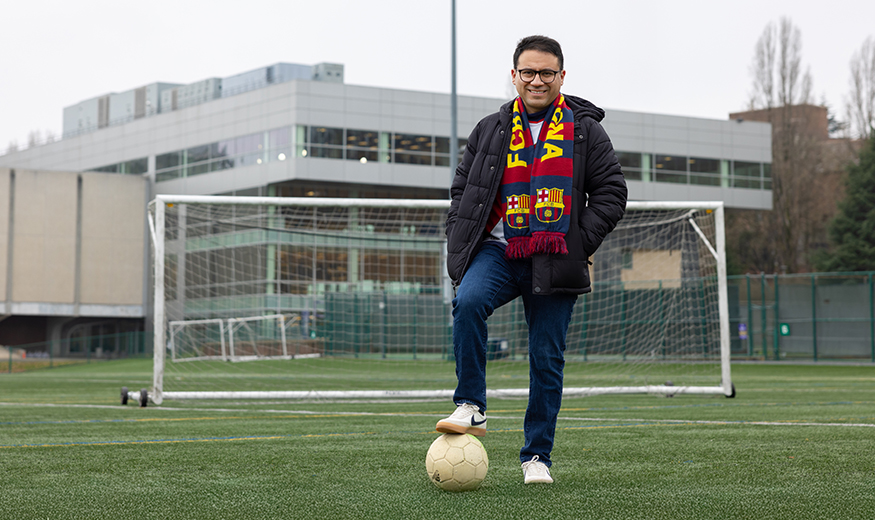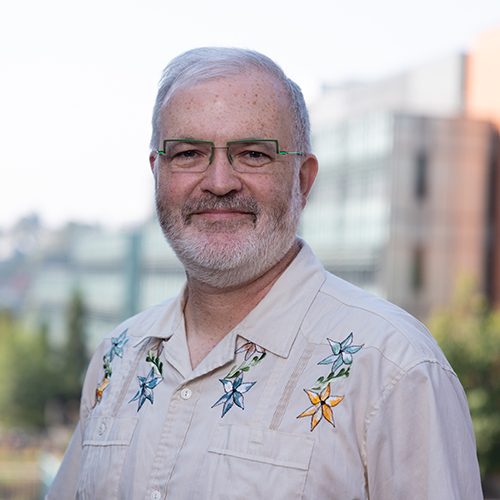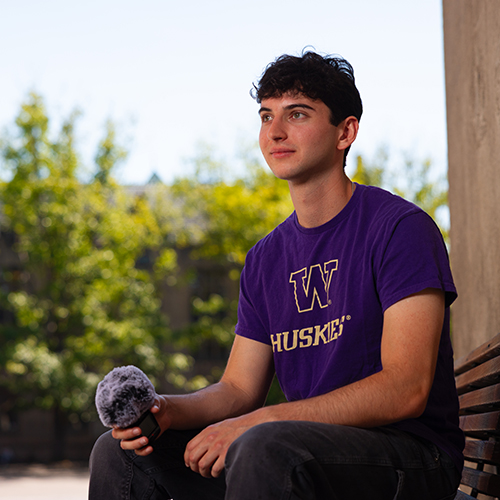
Talk to Jesús Hidalgo about soccer and you’ll never see the sport quite the same way. Yes, soccer is about athletic prowess. It is about team spirit and fans cheering for their favorites with gusto. But dig into soccer’s impact on the world as Hidalgo has, and a more complex picture emerges, with implications for economic power, nationalism, human rights, gender rights, and more.
The many facets of soccer are explored in “Sports and Global Affairs,” a course Hidalgo created and teaches in the Jackson School of International Studies. The course is part of the School’s Global Sport Lab. (See sidebar.)
Hidalgo, graduate program adviser in the Jackson School, was introduced to soccer by his father, who had been a talented soccer player in his youth in Peru, where Hidalgo grew up.
“My father was loving and caring but not really talkative,” says Hidalgo. “But our bond was really strong through soccer. For many years, the activity we did together was watching the game. When our team in Peru was playing, he would take me to the stadium. My father passed away three and a half years ago, and some of our last conversations were still about soccer.”
A Brief History of Soccer...or is it Football?
Hidalgo begins his course with the origins of soccer. Some ancient ball games were precedents for the sport, but modern soccer was introduced in the nineteenth century as a way to tame unruly boys at elite schools in England. The sport was inspired by a violent street sport called “mob football” that had gained popularity among England’s working class.
“At England’s elite schools, the students were elite, but the teachers were not, which created some tension,” Hidalgo explains. “The directors thought, ‘We need to come up with something for these kids to respect us, to teach them about structure and rules. Sports will help us because lots of energy can be channeled there while also promoting team spirit and rule-following.’”

The schools introduced soccer, which proved popular. Students shared their passion for the sport during travels abroad, and many countries took to the sport enthusiastically. The United States, which was developing baseball as its own national sport, was slower to come around, though the US did participate in the first soccer World Cup in 1930.
That 1930 US team placed third, which would remain the best performance for a US men’s soccer team in the World Cup. US women’s soccer has fared better, with the team winning the very first FIFA (Federation Internationale de Football Association) Women’s World Cup in 1991 and three more FIFA World Cups since, plus another four top-three finishes.
It’s worth noting that the first FIFA Women’s World Cup was held 61 years after the first Men’s World Cup. Women did play the sport from early on in England — a factory team competed across England for charity purposes in the 1920s — but England’s soccer association then banned women from using any facilities related to soccer. (The women continued playing anyway.) Only after private soccer tournaments for women attracted impressive crowds in the 1970s and 1980s did FIFA, the world governing body for soccer, relent.
“It wasn’t that FIFA realized it was wrong to repress the right of women to participate in the sport,” says Hidalgo. “It was more like, ‘There’s money in hosting women’s tournaments. If we don’t host them, we’re going to lose that money.’ I call it the FOMO of FIFA, the fear of missing out.”
As for the term “soccer” in the US versus “football” in other countries, Hidalgo explains that “soccer” was first introduced in England as a not-entirely-obvious abbreviation for “Association Football.” The sport was called both soccer and football in England until the 1970s, around the time the US formed its own league, recruiting global stars like Pelé. As the US embraced the term “soccer,” the rest of the world committed fully to “football.”
A Global Phenomenon
Whatever one calls the sport, it has become a global phenomenon, with both economic and political implications. As early as 1934, Mussolini used Italy’s World Cup win as a propaganda tool. In 1978, when Argentina hosted and won the World Cup, it was an opportunity to deflect attention from the country's human rights violations. Today, nations with no historical connection to soccer are investing enormous resources toward recruiting star players and building powerhouse teams as a way to bolster their nation’s image or economy.
Hidalgo offers several recent examples. In Qatar, the government hopes that becoming a powerhouse on the world stage of soccer will lend the country legitimacy and distract from its human rights violations. In contrast, Saudi Arabia, selected to host the 2034 FIFA World Cup, makes no attempt to hide its dismal human rights and environmental record. Its primary interest in soccer is the potential economic gain of hosting a megaevent like the World Cup.

Many nations have less calculated reasons for embracing soccer, yet politics still seeps in. Matches can grow particularly heated when nations with an uneasy relationship compete, such as a country and its former colonizer. “You can see that when there is a France-Algeria game,” Hidalgo says. “The independence movement in Algeria was very violent, so there are still remnants of that. The feeling is, ‘We are proud of being Algerians. You were our colonizers, but we’re going to beat you because we’re better than you.’”
The impulse to embrace one’s team as symbol of national pride can play out in unexpected ways. When the women’s team from Thailand scored its first goal in a World Cup game, the whole nation celebrated despite the team’s overall weak performance in the tournament.
“Thailand was already losing that game — the score was 0-4 — but a Thai player scored a goal and everyone went nuts,” Hidalgo says. “The coach was in tears because now they were going to be part of a national story. The person who scored that goal is a national hero in Thailand even though they lost the game 5-1, because it was the very first goal a Thai player ever scored in a World Cup game.”
When more established teams compete, the expectations are quite different. And when a team falters, the fallout can reveal a darker side of nationalism in sports.
“At the end of the day, eleven people playing on the field are representing a whole nation,” says Hidalgo. “A lot of people are going to project their own dreams and hopes and aspirations onto that team. If the team wins, the fans feel the team represents them. But if that team doesn’t do well, people question whether the team represents their nation, particularly if the team has many immigrants and people of color. Turkish-German players on Germany’s team have been complaining that ‘When we win, we’re Germans. When we lose, we are foreigners.’”
The World Cup, The World Stage
Although Hidalgo has always been interested in soccer, it was anticipation of Seattle hosting six games of the 2026 FIFA Men’s World Cup that inspired his course, first offered in 2023. The World Cup is such a dominant event worldwide that Hidalgo devotes five class sessions to it.
“The World Cup is once every four years, so this anticipation bubbles up,” he says. “If your nation doesn’t make it all the way to the World Cup, you have to wait four more years for another chance. My nation, Peru, didn’t make it to the World Cup for 36 years. That’s why, in terms of fandom, the excitement makes sense.”

And why some nations spend a fortune campaigning to host the event. The massive sums some governments spend to be selected as World Cup host — and their reasons for hosting — is fascinating to undergraduate Jan Chen-Wernik, who took Hidalgo’s course in 2024.
“Though I knew about sportswashing — when leaders and countries use sports to shed their country and regime in a better light — I did not know how much of it had been happening historically,” says Chen-Wernik, a major in international studies with a minor in business.
Chen-Wernik also gained a new appreciation for the challenges Seattle will face as a World Cup host city. Hidalgo asks his students to consider how transportation and pressing social issues like homelessness will be addressed. Will preparation for the event lead to positive changes in the city, or will Seattle’s problems simply be hidden — or exposed to the entire world?
For Chen-Wernik, a lifelong soccer player and fan who hopes to pursue a career in the soccer industry, exploring such questions has only made him more convinced of his future path.
“Before this course, I struggled to connect my international studies major with the world of sports in which I want to work,” says Chen-Wernik. “But now I realize how sports is actually really intertwined with politics — especially foreign relations and policy. A sports event or a sports team can change how the world sees you as a country. The course gave me a lot of hope about how I might be able to help sports have a deeper meaning in the world, rather than only entertainment and commercial value.”
More Stories

A "gesture" to jump-start careers
To prepare students for professional success, the UW College of Arts and Sciences offers “gesture,” a mock startup company where student interns gain skills that employers seek.

Demystifying Quantum
In a physics course for non-STEM majors, Professor Miguel Morales teaches quantum mechanics without the advanced mathematics most quantum courses require.

Capturing the Sounds of Campus
With "University of Washington Soundscape," ethnomusicology and international studies major Leo Freedman has created an audio experience of the UW campus.
